Yes finally get to introduce you guys more on the making of coffee, in particular espresso. Warning, this is gonna be a long entry as we explore the various steps that goes into making a brew.
Of course the main actor of the day is the coffee beans. At Pitstop we use a blend of Arabica and Robusta beans. Arabica is supposely a better breed of coffee bean but Robusta beans can add bitterness and hence improve the overall blend of the coffee. Have you guys seen the beans used at the coffee shop? If you get the chance, you will notice that sweet corn is mixed in to reduce the cost of the beans and hence the quality is different as well.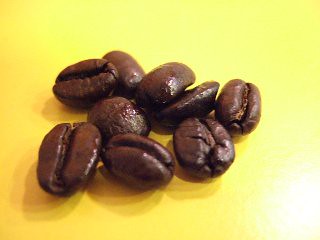
Nice smelling beans. Ask our stuff if you like to take a sniff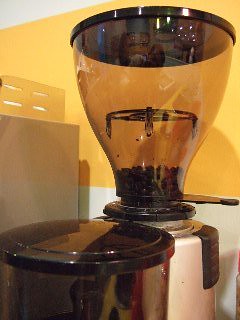
Beans awaiting to be sacrifice for that perfect brew...
As you might notice, there are very few beans in the grinder. Running out of beans? The thing with coffee beans is that once they are exposed to air, it aroma will slowly degrade. Hence at Pitstop we put just enough in the grinder for a couple of brew. The rest are kept in a air-tight container. 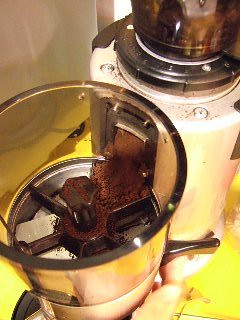
To ground the coffee beans need skill too. How fine should the powder be? Read on...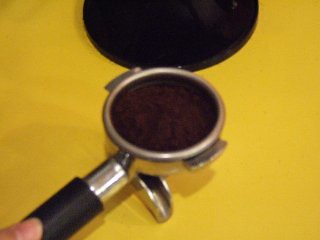
Just enough coffee powder for 2 shots of expresso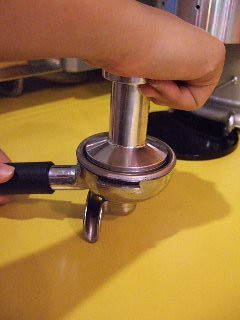
Pack the powder with a sufficient force...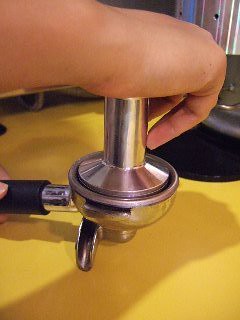
and end it with a twist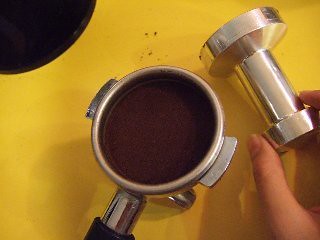
Nicely packed!
Compacting (tamping) the coffee powder uniformly is important to ensure a consistent brew. As you know, espresso is basically extracted by forcing water at high pressure through the coffee powder. Proper tamping ensures that the water force through the powder evenly, resulting a consistent extraction.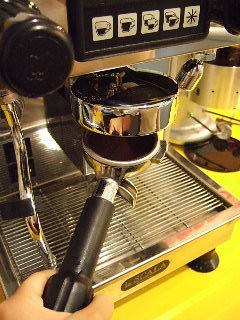
Push it into the head...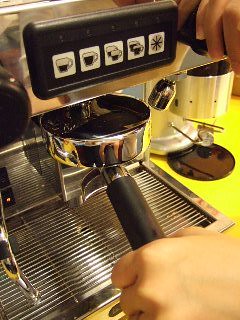
and lock it in!
This is important! The previous time i got sloppy and imagine the water forcing out at high pressure...not a nice sight!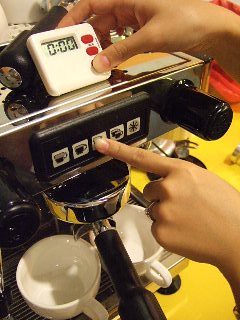
Getting ready for extraction...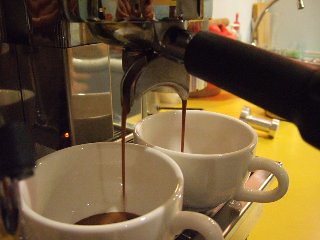
and here it comes...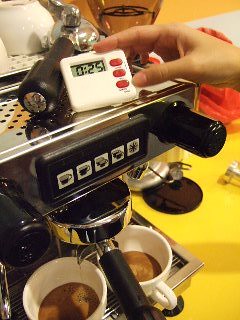
Extracted in approximately 25 to 28 seconds
Why do we need to time how long it need to extract? The reason is that a nice espresso should be extracted in around 24 to 32 seconds. If it is too fast, this means it is under extracted and the coffee is not as thick as it should be. Too slow, the espresso is over extracted and this lead to a bitter brew. So how do we adjust how long it take to come? We will need to grind the beans to the required granuality that will meet the required timing.
Are you bored already??? There are still more steps ahead! Frothing of the milk and it definitely not easy... 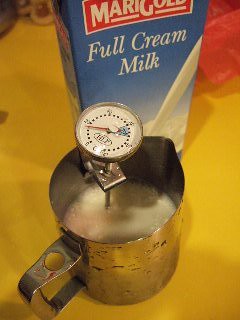
Start off with cold milk, it is easier for the milk to take in air making it easier to foam the milk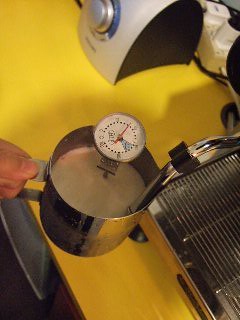
Foaming the milk...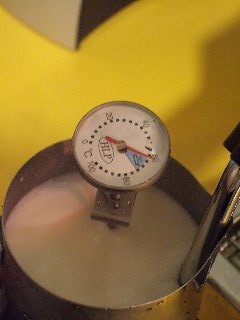
Continue heating the milk till the required temperature is reached. Milk steamed to the right temperature has a nice tint of sweetness...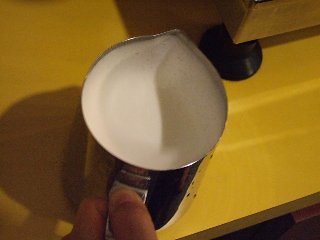
Give the milk a good bang and swirl till the milk reveal a nice sexy velvet surface
Frothing the milk is really tough. What you see outside is a more simplified approach. You get lots of foam and bubbles and that is really easy. However that is not the right technique. What you want is micro bubbles that is mixed well together with the milk. This will taste really nice instead of tasting just foam. Hence it take a lot of control to allow the right amount of air to be mixed in during the frothing step. 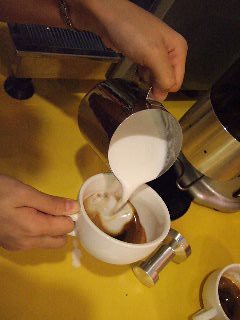
Pour it slowly...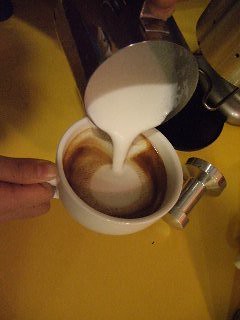
See the shape forming? Still not that well done, it should be a nice heart shape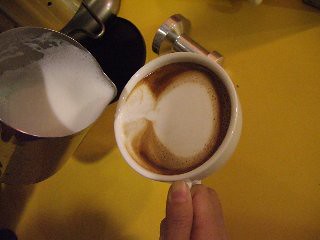
Finishing it off...
Seems easy??? You gonna to give it a try...really take a fair bit of practice. The key is getting the frothing of the milk right. The pattern is actually from the foam of the milk. It is a challenge to pour in by hand and has the milk blend with the espresso and have the foam on top. You need to froth the milk properly to do this! That is why in most places, what they do is to use a spoon to filter and just pour in the milk first. Next they use the spoon to scoop up the foam and place the foam on top.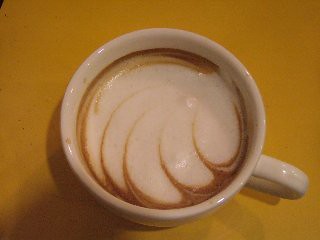
You can draw somthing nice...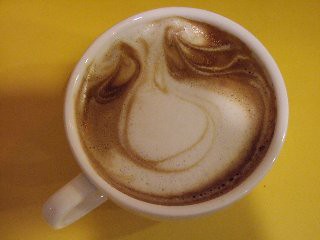
if not, its called abstract art...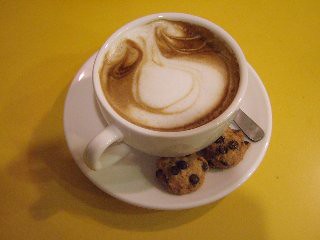
and serve with nice chocolate cookies
Phew this is indeed a long entry and hope you guys have found it interesting!
of course, we are not master barista yet! there are really more science and more art into making the perfect brew. However, at Pitstop cafe we ensure that meticulous care is taken to ensure that each cup we make is yet another step closer to perfection.
until then...
drop by at Pitstop for that perfect brew in the making!
BoyBoy
2006/01/24
What goes in a brew?
Posted by
pitstop
at
6:33 PM
![]()
Subscribe to:
Post Comments (Atom)





12 comments:
nice and informative post!
p.s. i think it's 'froth', not 'forth'
Wow... sounds so much like an art, you guys must have put in many nights of hard work to master it. Can't wait to try the expresso... my gang, when you guys free for another gathering ah?
We wasted countless coffeebeans in the learning of latte art. Do give us your comments after trying out the coffee ok? I recommend cappuccino in order to see the art! :)
Your coffee taste alright...but probably you want to sell at a cheaper price , $4 ++ a cup is too exp. maybe $3++
The correct term for your "packing" of coffee is tampering.
(yes the thing you use to do it is called a tamper)
And extraction time depends on beans besides granularity.
:)
er, to add to your post ...
the milk you use for your cappucinos/lattes also matter. you really should use fresh milk instead of UHT milk - it makes a big difference to the taste of the drink.
also, extraction should be volume dependent rather than time dependent, cos different machines will extract at different rates (some as short as 20 seconds) - 30ml for a single shot, 60ml for a double shot.
and the correct term for packing the coffee is tamping, not tampering.
nonetheless, great post for helping folks appreciate the effort needed in making that cup of espresso-based drink!
yup, the choice of word was meant actually to be informal but i do agree maybe the correct term used would be better for the readers. Thanks for pointing out. As for the extraction time, our machine for a single shot is 30 ml, that is where we get the 24 to 30 seconds from. Yeah you are correct to point out different beans affect extraction time as well as things like humidity, etc. Therefore most of the time we use the timing as a guide, and observe the creme and the taste to confirm.
Anyway thanks for the comment!
sorry but it's crema not creme.
i sure hope your enthusiasm pays off, there're not many joints that serve gd coffee.
also if your's is a guide to good coffee, or 'educating' about gd coffee, you've jumped too far into the beans debate and ignoring the more impt question of roasting. so where do you get your beans from and who roasts them?
Sweet corn is not exactly added like a separate component to local coffee.
Rather, it is roasted together in which you will not see indivdual sweet corn kernels. I remember that it is crushed to a powder and roasted together with the coffee beans, magarine and sugar. Some places like malaysia use sesame oil.
Yes, i do see before the roasted black individual sweet corn kernels mixed with the coffee bean. There is no debate on the beans rather i am just trying to share facts which i think is interesting (i never know that other stuff are mixed with coffee beans).
Just to keep in mind that i wrote the entry is more of sharing what i know and some personal experience. As for "educating", i believe all the anonymous posters are doing a much better job!
interesting how pple in singapore do it...over in aus (where I learnt how to make coffee) the time always remains at 20sec flat while the grind has to be altered. it takes less time I guess!
and I LOVE those corn kernels in my coffee. My friend's aunt and uncle actually fly it over to aus and the US through customs and all.
i guess it is not how people in Singapore do it but rather how we do it :) The timing is base on what we learn as well as info on the map. I guess a slighly longer time extract a thicker shot and with a slight tinge of bitterness..i maybe wrong though
Post a Comment